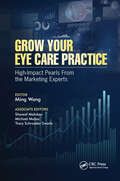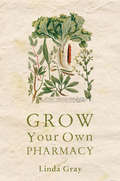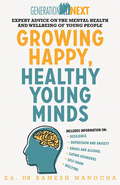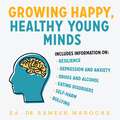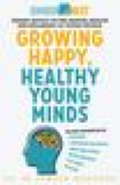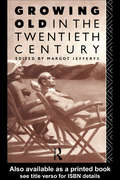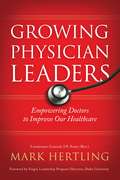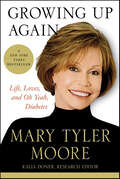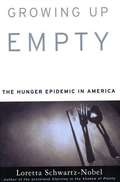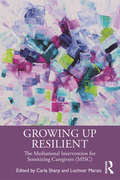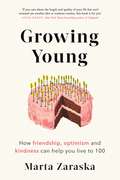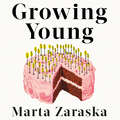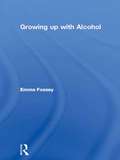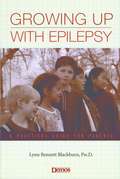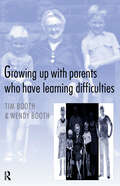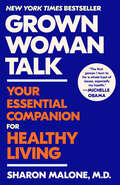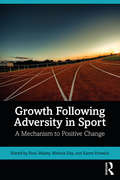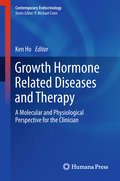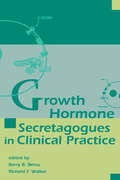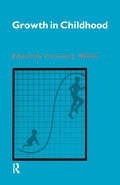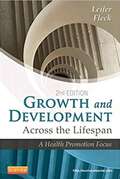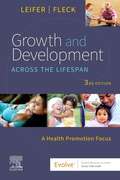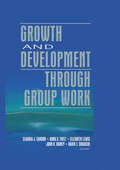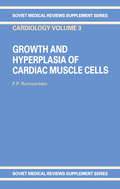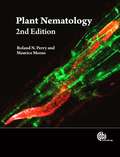- Table View
- List View
Grow Your Eye Care Practice: High Impact Pearls from the Marketing Experts
by Ming WangA crash course in marketing for eye care professionals, Grow Your Eye Care Practice: High Impact Pearls from the Marketing Experts guides readers through this crucial area of business development.With an increase in patients undergoing elective procedures and an increase in the amount of providers, marketing has become the most important way for eye care professionals to grow their practices and differentiate themselves from their competition. Since marketing is not addressed in any formal course in medical school, optometry school, residency or fellowship, many eye care professionals lack basic understanding and skills in this area of growing importance to their businesses.To meet this critical need, editor Dr. Ming Wang and associate editors Shareef Mahdavi, Michael Malley and Dr. Tracy Swartz have created this essential, timely handbook aggregating the key ophthalmic marketing pearls, teachings and experiences of some of the leading national and international marketing experts.Grow Your Eye Care Practice begins with an overview of the history and current state of ophthalmic marketing, including a fascinating look at the commoditization of eye care as was demonstrated with the introduction of LASIK. The core chapters address foundational and innovative marketing concepts and their application to eye care, including: Market research, segmentation, targeting and positioning Patient experience Branding versus call to action Word of mouth referrals Digital marketing, including social media, websites and SEO Innovative marketing approaches Ethics and laws governing medical marketing Upcoming disruptive marketing technologies Grow Your Eye Care Practice: High Impact Pearls from the Marketing Experts is an indispensable desktop reference for all eye care professionals--ophthalmologists, optometrists, administrators, practice managers, business associates, residents, fellows, medical students and optometry students—who wish to improve their marketing skills, grow their practices and differentiate themselves from their competition.
Grow Your Own Pharmacy
by Linda GrayBuilding on the concept that the natural environment provides everything necessary to produce the vitamins and minerals for healthy bodies, minds, and souls, this book gives readers detailed instructions to determine what they personally need, and information for both growing and using those items. Recommended daily vitamins are listed, with a chart showing, at a glance, what foods are required to fill the daily need. Details on planning, planting, growing, and harvesting vegetables, herbs, and plants are provided, and additionally, recipes and meal ideas are included, along with an herbal tea checklist for alleviating symptoms of illness and lists of edible flowers with vitamin content. A valuable tool for guidance through the mountain of available health information, this guide helps to sort information for practical, everyday use.
Growing Happy, Healthy Young Minds: Expert Advice on the Mental Health and Wellbeing of Young People (Generation Next)
by Ramesh ManochaThe world is getting harder for young people, and for the people who care about them: parents, teachers, school counsellors and concerned relatives. Generation Next is an organisation that gathers experts in several fields to provide information for professionals - now that expertise is gathered in this volume for everyone else. Each chapter contains easily accessible information, along with more detail and resources for those who wish to find out more. In this comprehensive volume there will be the latest information on many topics, including: Helping young people get help for mental health problems Bullying Anxiety Depression Understanding self-harm Child sexual abuse Alcohol and Drugs and how to communicate with young people about them Teens, Parties and Alcohol: A practical guide to keeping them safe Eating Disorders Body Image Resilience and Positive Psychology Understanding the Teenage Brain Online Time Management
Growing Happy, Healthy Young Minds: Expert Advice on the Mental Health and Wellbeing of Young People (Generation Next)
by Ramesh ManochaThe world is getting harder for young people, and for the people who care about them: parents, teachers, school counsellors and concerned relatives. Generation Next is an organisation that gathers experts in several fields to provide information for professionals - now that expertise is gathered in this volume for everyone else. Each chapter contains easily accessible information, along with more detail and resources for those who wish to find out more. In this comprehensive volume there will be the latest information on many topics, including: Helping young people get help for mental health problems Bullying Anxiety Depression Understanding self-harm Child sexual abuse Alcohol and Drugs and how to communicate with young people about them Teens, Parties and Alcohol: A practical guide to keeping them safe Eating Disorders Body Image Resilience and Positive Psychology Understanding the Teenage Brain Online Time Management
Growing Happy, Healthy Young Minds: Generation Next
by Ramesh ManochaThis is the most authoritative and up-to-date collection of information about a range of issues affecting young people today, including drugs and alcohol, bullying, mental health and eating disorders.The world is getting harder for young people, and for the people who care about them: parents, teachers, school counsellors and concerned relatives. Generation Next is an organisation that gathers experts in several fields to provide information for professionals - now that expertise is gathered in this volume for everyone else. Each chapter contains easily accessible information, along with more detail and resources for those who wish to find out more.In this comprehensive volume is the latest information on many topics, including:Helping young people get help for mental health problemsBullying AnxietyDepressionUnderstanding self-harmChild sexual abuseAlcohol and Drugs and how to communicate with young people about themTeens, Parties and Alcohol: A pratical guide to keeping them safe Eating DisordersBody ImageResilience and Positive PsychologyUnderstanding the Teenage BrainOnline Time ManagementComing in September 2017 is volume 2 in the Generation Next collection: Nurturing Young Minds: Mental Wellbeing for the 21st Century
Growing Old in the Twentieth Century
by Margot JefferysGrowing Old in the Twentieth Century investigates many aspects of the current debates raging regarding care and provision for the elderly and the very elderly. It will be invaluable to gerontologists, social policy makers, official and unofficial carers, and anyone involved in health care.
Growing Physician Leaders: Empowering Doctors to Improve Our Healthcare
by Mark HertlingCan a general teach America’s doctors to be better leaders?Hospitals, clinics, and healthcare organizations across the nation are wondering, “Can we transform healthcare by improving physician leadership? And if so, how?” Healthcare today faces both daunting challenges and exciting new possibilities. Physicians hold the key to improving healthcare, but while they enjoy exceptional training in the science of medicine, the vast majority of doctors have received little training in even the basics of leadership.In Growing Physician Leaders, retired Army Lieutenant General Mark Hertling applies his four decades of military leadership to the world of healthcare, resulting in a profoundly constructive and practical book with the power to reshape and reenergize any healthcare organization in America today. Designed to help physicians master the art of leading people, it takes them, step-by-step, through a proven process that can help anyone become a more effective leader.Growing Physician Leaders gives doctors a potent tool to improve their personal health, their professional health, their organizational health, and ultimately, our nation’s health.
Growing Up Again: Life, Loves, and Oh Yeah, Diabetes
by Mary Tyler MooreWith generosity of spirit, ebullience, and sly humor, Mary Tyler Moore presents the intensely private, often funny, and sometimes startling story of her life with diabetes. Growing Up Again is a delightfully candid read for her legion of fans, the more than 20 million Americans with diabetes, and everyone struggling to cope with life's unexpected challenges.Mary Tyler Moore, actress and activist, relates the highs and lows of living with type 1 diabetes for the past forty years. With inspired, well-crafted prose, she drills down to the most heartfelt, yet universal truths about life—including the lives of those with diabetes. She unflinchingly chronicles her struggle with diabetes, as well as her successful rehabilitation from alcohol dependence, all while deriving gratification from her roles as an actress, mother, businesswoman, campaigner, and fund-raiser. Her revealing tales of both her successes and failures in coping with diabetes offer others with the disease guidance and inspiration through example. In the book, stories include her rebounding from a low-blood-sugar episode during a Mary Tyler Moore Show script reading after the director poured orange juice down her throat, to misadventures caused by diabetes-related vision impairment at a dimly lit party for John Travolta.She also taps into the vast diabetes research network to talk to diabetic children and adults and with leading experts who are discovering new ways to control diabetes and its complications, and pursuing new ways to cure this disease."Her TV alter ego, Mary Richards, may have been perfect, but it’s Moore’s imperfections that make her the ideal author of this surprisingly frank memoir about living with diabetes." - Publishers Weekly
Growing Up Empty: The Hunger Epidemic in America, First Edition
by Loretta Schwartz-NobelGrowing Up Empty is a study of a hidden epidemic that still remains largely unacknowledged at the highest political levels. A call to action that will re-energize the national debate on the federal government's priorities, Growing Up Empty is advocacy journalism at its best.
Growing Up Resilient: The Mediational Intervention for Sensitizing Caregivers (MISC)
by Carla Sharp Lochner MaraisIt is universally accepted that sensitive and responsive caregiving leads to positive cognitive and socio-emotional outcomes for children. While several intervention approaches exist, this text brings together the rationale and current evidence base for one such approach—the Mediational Intervention for Sensitizing Caregivers (MISC). MISC integrates aspects of socio-emotional health and cognitive development as well as being less culturally intrusive than existing approaches. It is a strengths-based program complementing existing practices and cultures. Editors bring together in one volume the theory and research from the last decade supporting the MISC approach. Chapters focus on a range of topics, such as training the trainer, maternal depression and MISC, applying MISC to families reunited after migration-related separation and more. The book also focuses on several country-specific cases, such as applying MISC to HIV/AIDS-affected children in South Africa or in early childhood care settings in Israel. This book is essential reading for those working in early educational or clinical settings tasked with developing policy to ensure optimal child developmental outcomes. The book is applicable to professionals from a wide variety of disciplines including clinical, counselling, educational, psychology, psychiatry, paediatrics, nursing, social work and public health.
Growing Young: How Friendship, Optimism and Kindness Can Help You Live to 100
by Marta Zaraska'If you care about the length and quality of your life but can't stomach yet another diet or workout routine, this book is for you' - Adam Grant, New York Times bestselling author 'Finally, a lifestyle book that transcends diet and exercise for solutions for living longer' - Dan Buettner, National Geographic Fellow and New York Times bestselling author A smart, research-driven case for why optimism, kindness and strong social networks will help us live to 100.What to do to live long? From fountain-searching Ponce de Leon to pill-popping Silicon Valley techies humanity has been trying to pinpoint the answer for centuries, often fixating on all the wrong things: miracle diets, miracle foods, miracle supplements. We skip gluten and invest in exercise gadgets. We swallow vitamins. We obsess about BMI. While healthy nutrition and physical activity are indeed important for health, there are things we all too often sacrifice in favour of fad diets that have an outsize impact on our centenarian potential. Friendships. Purpose in life. Empathy. Kindness. Science shows that these 'soft' health drivers are often more powerful than diet and exercise.Consider the numbers: studies show that building a strong support network of family and friends lowers mortality risk by about 45 per cent. Exercise, on the other hand, can lower that risk by 23 to 33 per cent. Eating six servings of fruit and veg per day can cut the danger of dying early by 26 per cent, while following the Mediterranean diet by 21 per cent. For volunteering, it's 22 to 44 per cent. Many more examples like this led Marta Zaraska to her ultimate conclusion: you should be contemplating your purpose in life, not the best fitness tracker to buy.Humans are social animals. Over the course of our evolution we've developed intertwined systems that regulate our social lives on one hand and our physiology on the other, contributing to our centenarian potential. The amygdala and the insula in the brain, the social hormones oxytocin and serotonin, the vagus nerve, the HPA stress axis - these all link our bodies and our minds, contributing to our centenarian potential. We feel safe when we are surrounded by friendly others. The nervous system, the gastrointestinal system, the immune system all function properly when the tribe is there for us and when we are there for the tribe. We flourish as part of a group.Marta Zaraska based Growing Young on hundreds of research papers and on interviews with dozens of leading scientists from fields as diverse as molecular biochemistry, cyber psychology, marketing and zoology. The book's research took her to rather unexpected places, too: catching wild mice in the woods of England, sipping super-smoothies at a longevity bootcamp in Portugal and arranging flowers with octogenarians in Japan. In the end, all the studies, the interviews and the travels brought her to a simple conclusion: self-improvement, commitment to growing as a person, can also help us grow younger. To Michael Pollan's famous statement on health: 'Eat food, not too much, mostly plants,' she now adds: 'Be social, care for others, enjoy life.'
Growing Young: How Friendship, Optimism and Kindness Can Help You Live to 100
by Marta Zaraska'If you care about the length and quality of your life but can't stomach yet another diet or workout routine, this book is for you' - Adam Grant, New York Times bestselling author 'Finally, a lifestyle book that transcends diet and exercise for solutions for living longer' - Dan Buettner, National Geographic Fellow and New York Times bestselling author A smart, research-driven case for why optimism, kindness and strong social networks will help us live to 100.What to do to live long? From fountain-searching Ponce de Leon to pill-popping Silicon Valley techies humanity has been trying to pinpoint the answer for centuries, often fixating on all the wrong things: miracle diets, miracle foods, miracle supplements. We skip gluten and invest in exercise gadgets. We swallow vitamins. We obsess about BMI. While healthy nutrition and physical activity are indeed important for health, there are things we all too often sacrifice in favour of fad diets that have an outsize impact on our centenarian potential. Friendships. Purpose in life. Empathy. Kindness. Science shows that these 'soft' health drivers are often more powerful than diet and exercise.Consider the numbers: studies show that building a strong support network of family and friends lowers mortality risk by about 45 per cent. Exercise, on the other hand, can lower that risk by 23 to 33 per cent. Eating six servings of fruit and veg per day can cut the danger of dying early by 26 per cent, while following the Mediterranean diet by 21 per cent. For volunteering, it's 22 to 44 per cent. Many more examples like this led Marta Zaraska to her ultimate conclusion: you should be contemplating your purpose in life, not the best fitness tracker to buy.Humans are social animals. Over the course of our evolution we've developed intertwined systems that regulate our social lives on one hand and our physiology on the other, contributing to our centenarian potential. The amygdala and the insula in the brain, the social hormones oxytocin and serotonin, the vagus nerve, the HPA stress axis - these all link our bodies and our minds, contributing to our centenarian potential. We feel safe when we are surrounded by friendly others. The nervous system, the gastrointestinal system, the immune system all function properly when the tribe is there for us and when we are there for the tribe. We flourish as part of a group.Marta Zaraska based Growing Young on hundreds of research papers and on interviews with dozens of leading scientists from fields as diverse as molecular biochemistry, cyber psychology, marketing and zoology. The book's research took her to rather unexpected places, too: catching wild mice in the woods of England, sipping super-smoothies at a longevity bootcamp in Portugal and arranging flowers with octogenarians in Japan. In the end, all the studies, the interviews and the travels brought her to a simple conclusion: self-improvement, commitment to growing as a person, can also help us grow younger. To Michael Pollan's famous statement on health: 'Eat food, not too much, mostly plants,' she now adds: 'Be social, care for others, enjoy life.'
Growing up with Alcohol
by Emma FosseyThe use and misuse of alcohol by young people is an established concern. Initiatives designed to educate the young about the potential dangers of alchol are frequently directed solely at teenagers. Growing up with Alcohol argues that this may be leaving it too late. Emma Fossey presents a detailed account of a study of children aged between five and ten years, carried out through a series of ingenious game-like activities. She explodes the myth that young children are ignorant about alcohol and provides valuable insights about how very young children learn about alcohol and about their early perceptions of alcohol. The study questions the effectiveness of past alcohol education and argues strongly that future initiatives should develop innovative and user-friendly alcohol education materials for use in primary as will as in secondary schools and colleges.
Growing up with Epilepsy: A Practical Guide For Parents
by Lynn Bennett BlackburnBlackburn, a pediatric neuropsychologist at St. Louis Children's Hospital, shows parents how to support social development, advocate for a child with epilepsy in the educational system, and provide effective discipline. Early chapters present essential information on understanding epilepsy, behavior management, and school programming. The rest of the book concentrates on developmental stages as they are affected by the effects of epilepsy on social development.
Growing up with Parents who have Learning Difficulties
by Tim Booth Wendy BoothGrowing up with Parents who have Learning Difficulties uses a life-story approach to present new evidence about how children from such families manage the transition to adulthood, and about the longer-term outcomes of such an upbringing. It offers a view of parental competence as a social attribute rather than an individual skill, assessing the implications for institutional policies and practices. The authors address the notion of children having to parent their disabled parents and argue for a shift in emphasis from protecting children to supporting families.This innovative book provides a fresh approach to a subject rife with prejudice and challenges us to think again about many taken-for-granted ideas about the process of parenting and the needs of children. It also demonstrates the power of narrative research and its capacity for bringing alive people's experience in a way that enables us to better understand their lives.
Grown Woman Talk: Your Essential Companion for Healthy Living
by Sharon Malone M.D.NEW YORK TIMES BESTSELLER • &“A must-read for anyone who cares about their quality of life . . . Dr. Sharon Malone is the first person I turn to for a whole host of issues, especially my health.&”—MICHELLE OBAMAA practical guide to aging and health for women who have felt ignored or marginalized by the medical profession, from a leading OB/GYN and expert on menopausal and post-reproductive healthAN NPR BEST BOOK OF THE YEARThere&’s not enough talk around women&’s health, and what little there is rarely helps. Women are routinely warned, lectured, or threatened about their health. Or they are ignored, dismissed, or shamed. But they are rarely empowered. And empowerment, more than anything, is what women—and women of color, in particular—need.Grown Woman Talk is for every woman who has felt marginalized or overwhelmed by a healthcare system that has become more impersonal, complex, and difficult to navigate than ever. It&’s also for any woman who is simply standing at the intersection of aging and health, anxious and wanting solutions.Part medical handbook, part memoir, and part sister-girl cheerleader, this book is filled with useful resources and real-life stories of victory and defeat. It not only highlights the current data around women&’s health issues, but it also places that data in a helpful context.In a tone that is lively and intimate but unflinchingly direct, Dr. Sharon Malone details how to live better, age better, and get better medical treatment, especially when it&’s most needed. This is not a medical activism book designed to fight the power. This is a book designed to show women that they already have the power—they need only to increase their capacity and willingness to use it.Most important, Grown Woman Talk seeks to eradicate the silence that surrounds women&’s health by facilitating discussion between women of all ages and encouraging more accurate and productive medical insights. It is Dr. Sharon&’s belief that giving women more agency can, literally, give them life.
Growth Following Adversity in Sport: A Mechanism to Positive Change
by Ross WadeyGrowth Following Adversity in Sport: A Mechanism to Positive Change is the first text to carefully consider the positive changes that may follow adverse experiences in sport at micro (e.g., individual), meso (e.g., dyadic, team), and macro levels (e.g., organizational, cultural). While remaining respectful of the despair and distress that can follow adversity, this comprehensive text aims to provide a narrative of hope to those who have experienced adversity in sport by showcasing the latestadvances in research on growth following adversity. This book covers topics as diverse as: conceptual, theoretical, and methodological considerations; cultural, organizational, and relational perspectives; population-specific insights (e.g., gender, disability, youth); and applied implications (e.g., evidence-based, practice-based). Written and edited by a team of international experts and emerging talents from around the world, each chapter considers the nature and meaning of growth, contains a comprehensive review of empirical research or reflections from professional practice, and offers exciting, novel, and rigorous suggestions for future programs of research that aim to promote positive change in sport to support the safety, wellbeing, and welfare of the people who take part (e.g., athletes, coaches, paid employees, volunteers). Cutting-edge, timely, and comprehensive, Growth Following Adversity in Sport: A Mechanism to Positive Change is essential reading for postgraduate students and scholars in the fields of sport psychology, injury and rehabilitation, sport theory and other related sport science disciplines.
Growth Hormone Related Diseases and Therapy
by Ken HoThe molecular era ushered in the cloning of the growth hormone (GH) gene and the production of unlimited amounts of GH through recombinant technology. The continuing momentum of research from basic science to clinical evaluation has brought unprecedented advances to the understanding of GH biology for the clinical endocrinologist. Growth Hormone Related Diseases and Therapy: A Molecular and Physiological Perspective for the Clinician distills all the new information of relevance to the endocrinologist over the last 20 years by offering five sections: physiology, molecular genetics, GH deficiency, acromegaly and pharmacotherapy. The first section on physiology focuses on GH action. A review on the structure and function of the GH receptor is followed by a perspective on the regulatory role of ghrelin on GH secretion. The second section on genetics covers pituitary function and adenomas, including new and fascinating information on familial pituitary adenomas, their genotype and phenotype. The adult GH deficiency section spans the epidemiology and diagnosis of GH deficiency with a strong reminder for the clinician that the transition period represents a critical time of somatic maturation, which continues for years after cessation of liner growth. The section on acromegaly focuses on management, giving practical guides to the value of GH and IGF-1 measurements, the place of somatostatin analogues and of radiotherapy while reminding the reader as to why evaluating quality of life is an important part of management. Finally, the section on GH pharmacology takes the reader through innovative developments of long-acting GH formulations with some products on the threshold of clinical use. This section provides a balanced evidence based review of the effects of GH supplementation in aging and in sports where recent data indicates an enhancing effect on a selective aspect of performance. Growth Hormone Related Diseases and Therapy: A Molecular and Physiological Perspective for the Clinician integrates a wealth of information and will prove an invaluable reference for pediatric endocrinologists, adult endocrinologists, endocrine scientists and internists interested in the human biology of GH.
Growth Hormone Secretagogues in Clinical Practice
by Barry B. Bercu Richard F. WalkerRecognizing the urgent need for an up-to-date review of new and innovative research on growth hormone (GH) secretagogues, this exclusive work furnishes the state of the art on the mechanisms of action, design, synthesis, evaluation, and clinical applications of GH secretagogues, including orally active and xenobiotic GH-releasing compounds. Beg
Growth In Childhood
by Terence J WilkinFirst Published in 1989 this is a collection of essays based on a series of lectures given at a symposium held at the University of Southampton Medical School from eight experts in the field of growth failure. Interest in growth hormone, its regulation and its therapeutic use has grown enormously since the introduction of genetically engineered growth hormone in 1985. The very pratcial probelms of measuring growth, the physiology of growth failure and its epidemiology are followed by a richly illustrated chapter on the spectrum of diseases assciated with short stature and an expert with extensive experience in the field looks at the application of growth hormone therapy.
Growth and Development Across the Lifespan: A Health Promotion Focus
by Gloria Leifer Eve FleckThis book provides introductory coverage of growth and development throughout the lifespan. The content emphasizes normal aspects as well as the unique problems and health promotion needs of each age and stage of development. It features a strong health promotion theme structured around Healthy People 2020 objectives. <p><p>Lifespan coverage from prenatal development to death helps students integrate concepts related to normal changes in each stage of the life cycle. Coverage of current research and trends in health care provide readers with the most up-to-date, accurate information. Health promotion and disease prevention, including Healthy People 2020 objectives, are highlighted throughout the book. Cultural content is highlighted throughout the book and in new Chapter 3: Cultural Considerations in Health Care to encourage students to consider cultural implications at every stage of development. <p><p>Separate chapter on advanced old age and geriatrics (Chapter 14) discuss the theories, physiological changes, and psychological aspects of aging; health promotion and maintenance; and the role of health care providers in caring for the geriatric patient. All of this helps students understand how to maintain quality of life and promote health in advanced old age. <p><p>Teaching techniques for every developmental stage are part of a consistent chapter format and provide age-appropriate patient education tips. Consistent chapter organization for each stage of growth and development makes information easy to access. Critical Thinking scenarios and questions appear at the end of each chapter to help students consider all variables when planning care across the lifespan. Student learning features include Objectives, Key Terms, Key Points, and Review Questions. Appendix A includes the FDA's Recommended Child and Adult Immunization Schedules, providing essential health promotion information. <p><p>NEW Appendix B provides a Multilingual Glossary of Symptoms to enhance students' awareness of culturally sensitive care. Glossary includes definitions of Key Terms and additional terms help students review concepts and terminology at a glance. Bibliography is organized by chapter at the end of the book to facilitate additional research and study.
Growth and Development Across the Lifespan: A Health Promotion Focus
by Gloria Leifer MA RN CNE Eve Fleck MS ACE GFI ACE PT NASM CPTPromote healthy behaviors and healthy lifestyles throughout the life cycle! Growth and Development Across the Lifespan, 3rd Edition helps you plan and implement appropriate care for patients at each age and stage of life. Explaining concepts of physical, cognitive, social, and personality development, this text provides strategies for improving patient health and quality of life for each age group. Healthy People 2030 objectives are used to set a framework for positive health behaviors. From noted educators and authors Gloria Leifer and Eve Fleck, this book shows how a knowledge of normal growth and aberrations can be used to design individual approaches to patient care.
Growth and Development Through Group Work
by Elizabeth Lewis Claudia Carson Anna FritzExamine group work's roots and fundamental beliefs to get a glimpse of the future For more than 80 years, social group work has survived difficult times-a testament to the persistence of its practitioners as well as the strength of its methods. Growth and Development Through Group Work chronicles the evolution of this groundbreaking practice through a collection of peer-reviewed papers presented at the 23rd Annual International Symposium on Social Work with Groups. The book examines practice, policy, and education issues in specific settings and populations from both theoretical and historical perspectives. Presented in the wake of the September 11 terrorist attacks in New York City and Washington, DC, the papers that comprise Growth and Development Through Group Work reflect a heightened awareness of the importance of social action group work-now, and in the future. The book represents the best of social work&’s tradition of social reform and concern for oppressed people, never straying far from the concept of the group, with its multiple helping relationships, as the primary source of change. A comprehensive overview of the field in international, intercultural, and cross-gender contexts, Growth and Development Through Group Work is equally effective for coursework or independent reading. Topics addressed in Growth and Development Through Group Work include: contributions of the late Ruby B. Pernell to the development of social group work research in support of group work education and practice group work in Germany-its development from American roots and its current advances social justice as a major objective of group work practice teaching group work mutual aid in support groups for particularly sensitive health problems psychoeducational group work contributions from Hull House as guides for the future of social group workGrowth and Development Through Group Work is an invaluable resource for clinicians, neighborhood and community activists, educators and students, researchers, therapists, administrators, and anyone working in policy and/or program development.
Growth and Hyperplasia of Cardiac Muscle Cells
by P.P. RumyantsevFirst Published in 1991. This Volume three of a set of a monograph series publishing versions of some of the research reviewed in its companion series, Section A (Cardiology Reviews) of Soviet Medical Reviews.
Growth of Farm Animals
by Vernon Fowler Tony Lawrence Jan NovakofskiUnderstanding the processes that change the shape and composition of farm animals is fundamental to all aspects of production. Showing the progression from cell to tissue to entire animal, this comprehensive textbook provides an essential broad base for animal production, with key information on how animals grow and change in shape and composition, and factors that affect these processes. Illustrated with new photographs and focus boxes highlighting vital points, this updated third edition includes a new chapter on avian growth, an important source of protein for the expanding population. Providing a thorough, yet student-friendly approach to the subject, this book continues to fill the important role of helping readers to understand how the basics of growth must be thoroughly understood if farm animals are to be used efficiently and humanely in producing food for mankind.
